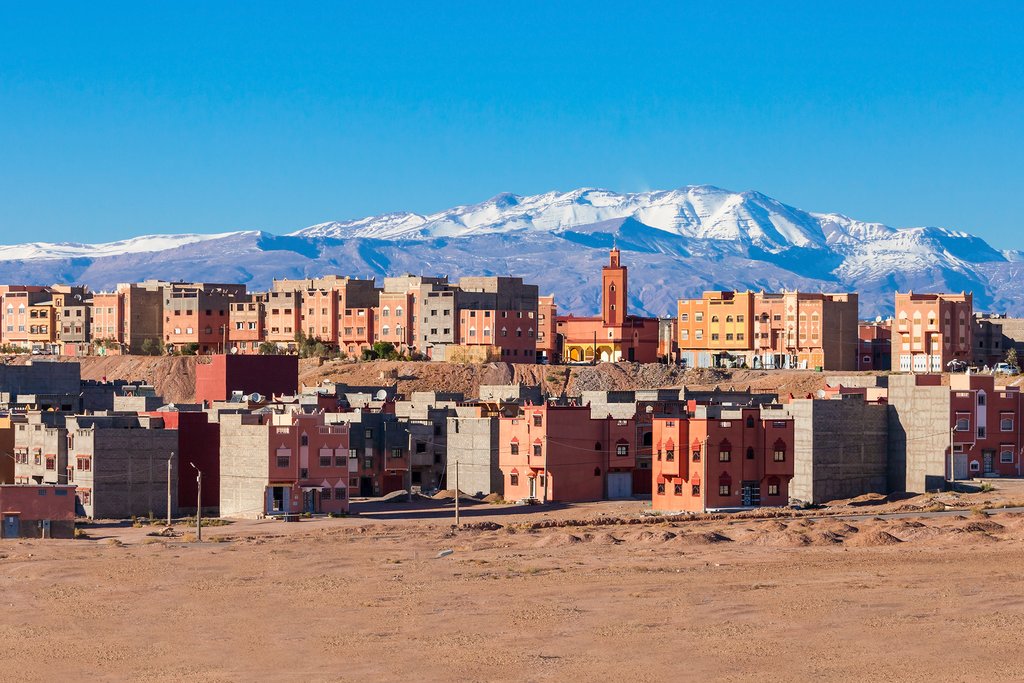Weather
Morocco's winter is mild. But January is the coldest month of the year—and also the wettest. Generally speaking, temperatures peak in the high 60s, with lows in the 40s, though it can get much colder in the Atlas Mountains and much warmer in the desert. Though it gets chilly after dark, January days are often warm and sunny in Morocco. On average, January sees seven to eight days of rainfall.
Crowds & Costs
From a sightseeing perspective, January is an excellent time to visit Morocco, as crowds are fewer at major tourist attractions and many hotels offer low-season rates. If you have your heart set on a particular boutique hotel or riad, you'll have better luck booking a stay in January—particularly in the second half of the month, when fewer travelers are competing for rooms.
Where to Go
Temperatures are relatively mild throughout the country in January, but major cities like Marrakech and Tangier tend to see more precipitation than usual. Bring an umbrella—or skip the rain entirely and head for the desert or the mountains. Destinations like Ouarzazate, offering easy access to the Sahara and the High Atlas range, are particularly pleasant (and dry) in January.
Another great option is the Atlantic coast, including the seaside city of Essaouira, where conditions are warmer than elsewhere in the country. Keep in mind when travel planning that southern Morocco is milder than northern Morocco in January, so the further south you go, the less you'll need to bundle up in warm clothing.
Chat with a local specialist who can help organize your trip.
What to Do
Thanks to the relatively cool weather, January is a good time to explore the Sahara Desert or hike in the High Atlas Mountains—though be aware that rain can make river levels rise in the mountains, rendering some trails unpassable. Trekking in the desert is a safer bet.
January is a calm time for sightseeing in cities like Fes and Marrakech, which tend to get overly busy with tourists during the high season. It's also the perfect time to break out your camera: conditions for photography are optimal during winter in Morocco, when the air is clear and free of dust.
January Events
Yennayer. Morocco celebrates Yennayer, also known as the Amazigh New Year, on January 12-13. The festival marks the start of the crop year in traditional Berber communities across the country; celebrations are particularly lively in the Berber villages of the Middle Atlas Mountains, where the locals sing, dance, and prepare traditional foods. If you'd like to experience Yennayer, head for a town like Agadir or Tiznit.
Anniversary of the Independence Manifesto / Proclamation of Independence. Morocco's official independence day is in March, but the country also celebrates its first attempt at independence from French colonial rule on January 11th. The Proclamation of Independence is a national holiday in Morocco, marked by street parades and festivals all over the country.
Traveling to Morocco in January? Check out these great itineraries.
Moroccan Desert & Hiking in the Atlas Mountains. The desert is cool, dry, and clear in January. This eight-day itinerary starts and ends in (potentially rainy) Marrakech, whisking travelers away to the heights of the High Atlas Mountains and the expanses of the Sahara Desert—and into the home of a local family.
Morocco Grand Tour: Cities, Desert, & the Coast. Take in a bit of everything, from imperial cities to the mountains to the desert to the coast, on this ten-day grand tour of Morocco that begins and ends in Casablanca. Highlights include camping out in the desert, kitesurfing in the Atlantic, exploring the old medina of Fes, and a cooking class where you'll learn how to cook tagine.
More Helpful Information
Morocco in December
Morocco in February
Best Time to Visit Morocco
Morocco Tour Ideas
